The thermal insulation materials for optical fibers market is anticipated to grow from USD 101.1 million in 2025 to USD 191.5 million by 2035, recording a CAGR of 6.6%. This expansion reflects a near doubling of market value over the decade, driven by the combined contributions of both volume growth and price shifts. On the volume side, rising deployment of high-capacity fiber optic networks, increasing penetration of data centers, and the demand for reliable long-distance connectivity contribute significantly to higher consumption of insulation materials. These factors enhance the scale of deployment, ensuring steady gains in market size.
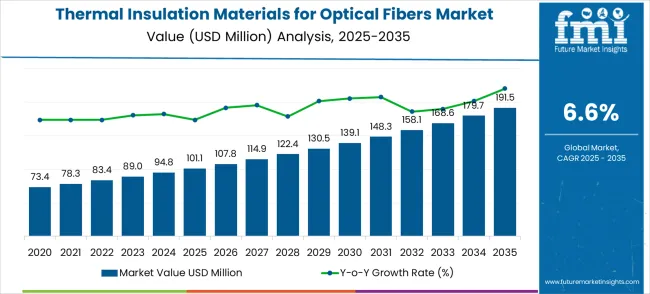
Price-related growth, while less pronounced than volume expansion, plays an important role in shaping overall market dynamics. Advancements in insulation material formulations, use of premium-grade compounds, and performance enhancements such as improved thermal resistance and durability contribute to incremental increases in average selling prices. Furthermore, stricter regulatory compliance and quality standards elevate the value proposition of higher-priced products. When analyzed together, volume expansion accounts for the larger portion of the absolute market increase, while price improvement acts as a supporting driver that sustains margins. The interplay of these two forces ensures balanced growth, with scalability of adoption providing the foundation and pricing dynamics adding resilience.
Emerging trends include development of ultra-thin, high-strength, and low-thermal-conductivity insulation materials. Manufacturers are innovating with ceramic composites, aerogels, and advanced polymers to enhance fiber durability. Growth is supported by rising adoption of 5G infrastructure, cloud computing, and satellite communications. Partnerships between insulation suppliers and optical fiber producers enable customized materials tailored to bandwidth, durability, and performance needs. Focus on heat resistance, signal reliability, and lightweight design continues to drive market expansion worldwide. The thermal insulation materials for optical fibers market is categorized into telecom infrastructure (40%), data centers (28%), aerospace and defense applications (15%), medical devices (10%), and specialty electronics (7%). Telecom infrastructure dominates demand as reliable insulation is critical for signal integrity, especially in high-speed fiber networks.
Data centers adopt these materials to reduce thermal stress and maintain stable performance in high-density environments. Aerospace and defense use insulation to safeguard optical fibers under extreme conditions. Medical devices integrate insulated fibers for minimally invasive imaging and diagnostics. Specialty electronics rely on them for precision operations in sensors, lasers, and instrumentation.
| Metric | Value |
|---|---|
| Market Value (2025) | USD 101.1 million |
| Market Forecast Value (2035) | USD 191.5 million |
| Forecast CAGR (2025-2035) | 6.6% |
Market expansion is being supported by the rapid development of telecommunications infrastructure across developing economies and the corresponding need for reliable thermal protection systems for fiber optic cables in demanding environmental conditions. Modern telecommunications operations require precise temperature control and thermal stability to ensure optimal fiber optic performance and signal integrity. The superior thermal resistance and insulation characteristics of specialized thermal insulation materials make them essential components in demanding telecommunications environments where temperature fluctuations are critical.
Telecommunications operators are increasingly investing in high-quality insulation systems that offer enhanced thermal protection and reduced signal degradation over extended operational periods. Industry standards and performance specifications are establishing benchmarks that favor precision-engineered thermal insulation solutions with advanced temperature management capabilities.
The market is segmented by material type, application, and region. By material type, the market is divided into glass fiber insulation materials, ceramic fiber insulation materials, polyimide foam materials, aerogel insulation materials, and other configurations. Based on application, the market is categorized into optical fiber composite insulated cables, optical fiber communication systems, power transmission systems, industrial automation control systems, and other applications. Regionally, the market is divided into North America, Europe, East Asia, South Asia & Pacific, Latin America, and Middle East & Africa.
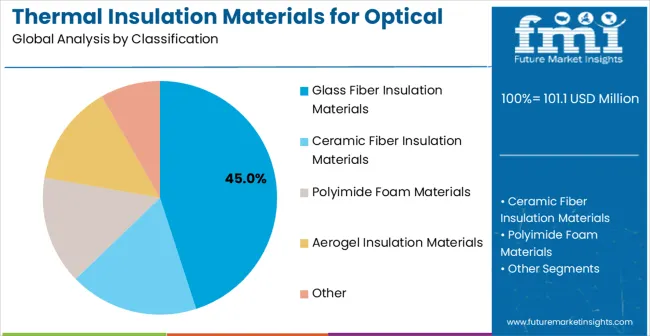
Glass fiber insulation materials are projected to account for 45% of the thermal insulation materials for optical fibers market in 2025. This leading share is supported by the increasing demand for cost-effective thermal protection in telecommunications applications and growing requirements for reliable insulation performance. Glass fiber insulation materials provide excellent thermal stability and mechanical strength, making them the preferred choice for optical fiber composite cables, telecommunications infrastructure, and industrial fiber optic applications. The segment benefits from technological advancements that have improved the thermal resistance and durability of glass fiber formulations while reducing manufacturing costs.
Modern glass fiber insulation materials incorporate advanced fiber processing, optimized resin systems, and sophisticated surface treatments that enhance thermal performance and extend service life. These innovations have significantly improved fiber optic protection while reducing total cost of ownership through enhanced durability and elimination of premature insulation failure costs. The telecommunications and industrial automation sectors particularly drive demand for glass fiber insulation solutions, as these industries require reliable thermal protection to maintain fiber optic integrity and comply with stringent performance standards.
The power transmission industry increasingly adopts glass fiber insulation materials to protect fiber optic sensors and meet international safety certifications. Cost-effectiveness requirements and performance reliability initiatives further accelerate market adoption, as glass fiber systems provide enhanced thermal protection while maintaining competitive pricing and installation efficiency.
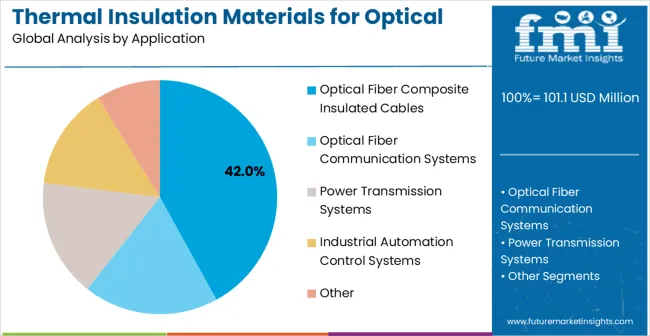
Optical fiber composite insulated cables applications are expected to represent 42% of thermal insulation materials for optical fibers demand in 2025. This significant share reflects the critical role of thermal insulation in fiber optic cable manufacturing and the need for reliable protection solutions capable of maintaining fiber integrity in diverse environmental conditions. Optical fiber composite cable manufacturers require effective and durable insulation systems for temperature protection, mechanical stability, and long-term performance reliability. The segment benefits from ongoing expansion of fiber optic infrastructure in developing countries and increasing performance requirements demanding enhanced insulation systems in telecommunications cable production.
Optical fiber composite cable applications demand exceptional thermal insulation performance to ensure signal quality and operational reliability. These applications require materials capable of handling extreme temperature variations, environmental stresses, and long-term exposure conditions. Emerging markets in Asia-Pacific, Latin America, and Middle East regions contribute significantly to market growth as telecommunications companies invest in modern cable technologies to improve network capabilities and service quality.
The trend toward underground and harsh environment cable installations create opportunities for specialized thermal insulation systems equipped with enhanced protective capabilities and environmental resistance features. The segment also benefits from increasing renewable energy integration and smart grid development driven by growing demand for reliable fiber optic monitoring and communication systems.
The thermal insulation materials for optical fibers market is advancing steadily due to increasing telecommunications expansion and growing recognition of fiber optic protection technology importance. However, the market faces challenges including material cost fluctuations, need for specialized application expertise, and varying temperature requirements across different fiber optic applications. Standardization efforts and performance certification programs continue to influence material quality and market development patterns.
The growing adoption of aerogel and nanotechnology-enhanced materials is enabling superior thermal insulation performance and lightweight characteristics in fiber optic insulation applications. Advanced material formulations and nano-scale engineering provide enhanced thermal resistance while optimizing mechanical properties and installation flexibility. These technologies are particularly valuable for high-performance telecommunications infrastructure that requires exceptional thermal protection and space-efficient installation requirements.
Modern thermal insulation manufacturers are incorporating flame-retardant properties and environmental resistance characteristics that improve overall protection capabilities while reducing system complexity through integrated functionality and specialized material properties. Integration of moisture barriers and mechanical protection enables comprehensive fiber optic protection and significant performance enhancement compared to traditional single-function insulation systems. Advanced manufacturing techniques and quality control processes also support development of more reliable and consistent thermal insulation materials for demanding telecommunications environments.
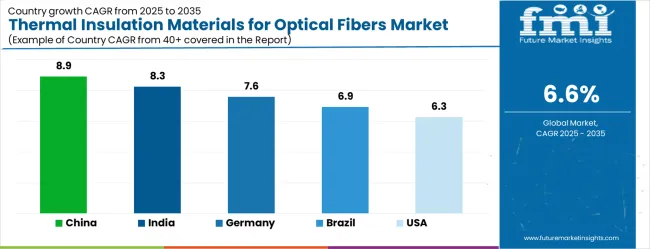
| Country | CAGR (2025-2035) |
|---|---|
| China | 8.9% |
| India | 8.3% |
| Germany | 7.6% |
| Brazil | 6.9% |
| United States | 6.3% |
| United Kingdom | 5.6% |
| Japan | 5.0% |
The thermal insulation materials for optical fibers market is growing rapidly, with China leading at an 8.9% CAGR through 2035, driven by massive telecommunications infrastructure expansion, 5G network development, and fiber optic manufacturing growth. India follows at 8.3%, supported by rising digital infrastructure investments and increasing adoption of fiber optic technologies in telecommunications and industrial applications.
Germany records strong growth at 7.6%, focusing on precision engineering, telecommunications excellence, and advanced materials capabilities. Brazil grows steadily at 6.9%, integrating thermal insulation materials into expanding telecommunications infrastructure and industrial automation facilities. The United States shows moderate growth at 6.3%, focusing on technology innovation and telecommunications modernization improvements. The United Kingdom maintains steady expansion at 5.6%, supported by telecommunications infrastructure programs. Japan demonstrates stable growth at 5.0%, prioritising technological innovation and materials excellence.
The report covers an in-depth analysis of 40+ countries, Top-performing countries are highlighted below.
The thermal insulation materials for optical fibers market in China is projected to exhibit the highest growth rate with a CAGR of 8.9% through 2035, driven by rapid telecommunications infrastructure expansion and massive 5G network development programs across urban and rural sectors. The country's growing fiber optic manufacturing and expanding telecommunications networks are creating significant demand for high-performance thermal insulation systems. Major telecommunications companies are establishing comprehensive insulation material installations to support large-scale fiber optic deployment operations and meet national connectivity standards.
China's telecommunications sector continues expanding rapidly, with major investments in 5G infrastructure, fiber-to-the-home networks, and industrial digitalization projects. The country's position as a global telecommunications equipment manufacturing hub drives substantial demand for reliable thermal insulation solutions that ensure fiber optic performance and operational durability across diverse environmental applications.
The thermal insulation materials for optical fibers market in India is expanding at a CAGR of 8.3%, supported by increasing digital infrastructure investments across telecommunications sectors and growing adoption of fiber optic technologies in telecommunications and industrial applications. The country's expanding digital India initiatives are driving demand for specialized thermal insulation systems capable of handling diverse environmental and installation conditions. Telecommunications facilities are investing in advanced insulation technologies to improve network reliability and comply with performance standards.
India's digital infrastructure development initiatives and telecommunications expansion create significant opportunities for thermal insulation material applications. The country's growing connectivity requirements drive demand for fiber optic networks and industrial automation systems, requiring reliable thermal protection solutions to maintain system performance and operational efficiency.
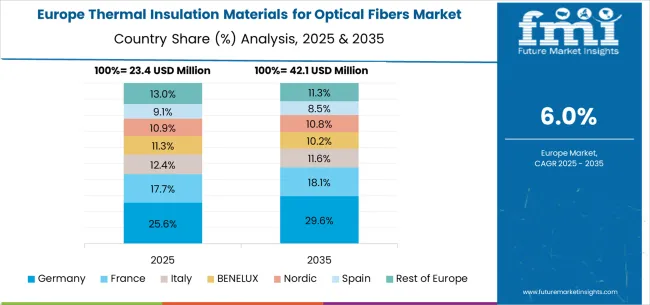
Demand for thermal insulation materials for optical fibers systems in Germany is projected to grow at a CAGR of 7.6%, supported by the country's focus on telecommunications excellence and advanced materials capabilities. German telecommunications facilities are implementing high-performance thermal insulation systems that meet stringent quality standards and operational reliability requirements. The market is characterized by focus on technological innovation, advanced materials, and compliance with comprehensive telecommunications regulations.
Germany's advanced telecommunications sector and materials excellence capabilities drive demand for high-quality thermal insulation solutions. The country's focus on network innovation, technological advancement, and materials precision creates opportunities for advanced insulation technologies that meet demanding telecommunications specifications.
The thermal insulation materials for optical fibers market in Brazil is growing at a CAGR of 6.9%, driven by expanding telecommunications infrastructure and increasing industrial automation system development across technology sectors. The country's growing connectivity initiatives are investing in advanced thermal insulation systems to improve network quality and performance in challenging environmental conditions. Telecommunications facilities are adopting modern insulation technologies to support growing connectivity requirements and service standards.
Brazil's expanding telecommunications infrastructure and industrial development create substantial opportunities for thermal insulation material applications. The country's growing digital economy and infrastructure expansion drive investments in fiber optic solutions that enhance connectivity competitiveness and operational efficiency.
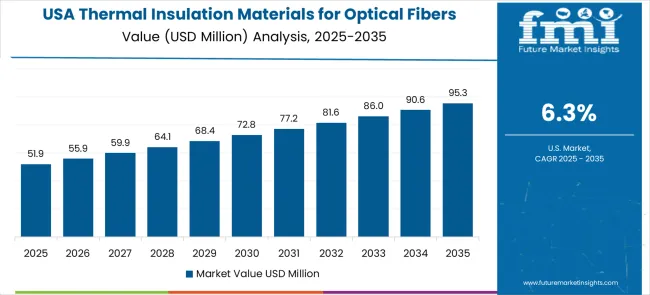
Demand for thermal insulation materials for optical fibers systems in the United States is expanding at a CAGR of 6.3%, driven by ongoing technology innovation and increasing prioritising on telecommunications network modernization solutions. Telecommunications facilities are upgrading existing fiber optic systems with advanced technologies that provide improved performance and enhanced network capabilities. The market benefits from replacement demand and infrastructure modernization programs across multiple telecommunications sectors.
The United States market focus on technology innovation, network advancement, and performance improvement in thermal insulation applications. Advanced research and development activities drive the adoption of next-generation insulation technologies that offer superior performance and operational reliability.
Demand for thermal insulation materials for optical fibers systems in the United Kingdom is projected to grow at a CAGR of 5.6%, supported by ongoing telecommunications infrastructure programs and network facility upgrades. Telecommunications operators are investing in reliable thermal insulation systems that provide consistent performance and meet regulatory compliance requirements. The market is characterized by focus on system reliability, operational efficiency, and telecommunications compliance across diverse network applications.
The United Kingdom's focus on telecommunications infrastructure and network excellence drives demand for high-performance thermal insulation solutions.
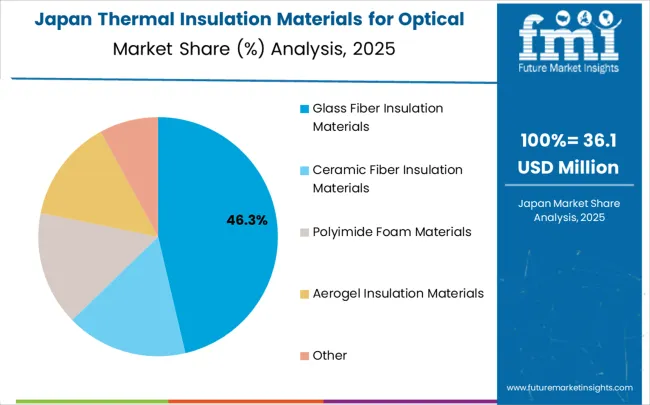
Demand for thermal insulation materials for optical fibers systems in Japan is expanding at a CAGR of 5.0%, driven by the country's focus on technological innovation and telecommunications excellence in materials applications. Japanese manufacturers are developing advanced thermal insulation technologies that incorporate precision engineering and efficiency-optimized design principles. The market benefits from focus on quality, reliability, and continuous improvement in telecommunications technology performance.
Japan's technological leadership and materials expertise drive the development of advanced thermal insulation solutions.
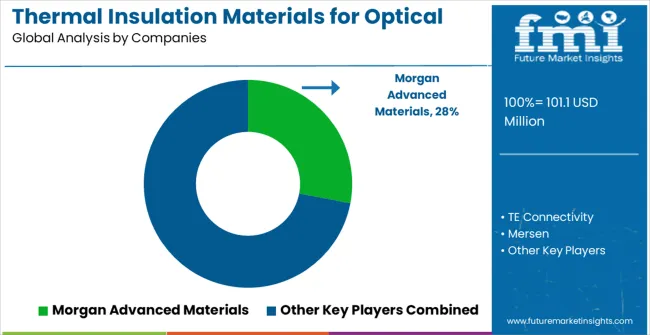
The thermal insulation materials for optical fibers market is defined by competition among established materials manufacturers, specialized telecommunications component companies, and emerging advanced materials providers. Companies are investing in advanced materials technologies, product innovation, standardized quality systems, and technical support capabilities to deliver reliable, efficient, and cost-effective thermal insulation solutions. Strategic partnerships, technological advancement, and geographic expansion are central to strengthening product portfolios and market presence.
Morgan Advanced Materials, operating globally, offers comprehensive thermal insulation solutions with focus on precision engineering, reliability, and technical support services. TE Connectivity, multinational manufacturer, provides advanced insulation systems with focus on telecommunications efficiency and application integration capabilities. Mersen, specialized provider, delivers innovative thermal insulation solutions for fiber optic applications with focus on performance and durability. Sumitomo Electric offers comprehensive insulation technologies with standardized procedures and global telecommunications service support.
Krosaki Harima provides advanced thermal insulation systems with focus is on high-temperature applications and technical expertise. Decon delivers specialized insulation solutions with focus on telecommunications and industrial applications. Aoyida Advanced Materials offers comprehensive thermal insulation technologies for demanding fiber optic environments with established manufacturing and service capabilities.
The competitive landscape includes established manufacturers focusing on research and development, product innovation, and market expansion strategies. Companies are investing in advanced materials technologies, precision manufacturing methods, and comprehensive technical support to maintain competitive positioning and market leadership.
The thermal insulation materials for optical fibers market underpins telecommunications infrastructure reliability, fiber optic performance excellence, network connectivity optimization, and digital communication advancement. With network performance mandates, stricter temperature protection requirements, and demand for reliable insulation systems, the sector must balance cost competitiveness, thermal efficiency, and materials sustainability. Coordinated contributions from governments, industry bodies, OEMs/technology integrators, suppliers, and investors will accelerate the transition toward performance-optimized, environmentally sustainable, and technologically advanced thermal insulation systems.
| Item | Value |
|---|---|
| Quantitative Units | USD 101.1 million |
| Material Type | Glass Fiber Insulation Materials, Ceramic Fiber Insulation Materials, Polyimide Foam Materials, Aerogel Insulation Materials, Other |
| Application | Optical Fiber Composite Insulated Cables, Optical Fiber Communication Systems, Power Transmission Systems, Industrial Automation Control Systems, Other |
| Regions Covered | North America, Europe, East Asia, South Asia & Pacific, Latin America, Middle East & Africa |
| Country Covered | United States, Germany, India, China, United Kingdom, Japan, Brazil, and other 40+ countries |
| Key Companies Profiled | Morgan Advanced Materials, TE Connectivity, Mersen, Sumitomo Electric, Krosaki Harima, Decon, Aoyida Advanced Materials |
| Additional Attributes | Dollar sales by material type and application segments, regional demand trends across North America, Europe, and Asia-Pacific, competitive landscape with established manufacturers and emerging suppliers, buyer preferences for high-performance versus cost-effective thermal insulation systems, integration with advanced fiber optic and telecommunications technologies, innovations in materials science and nanotechnology for enhanced thermal protection and durability, and adoption of multi-functional insulation solutions with embedded protective capabilities and environmental resistance for improved telecommunications performance. |
The global market is estimated at USD 101.1 million in 2025.
The market is projected to reach USD 191.5 million by 2035.
Growth is expected at a 6.6 percent CAGR during 2025 to 2035.
Glass fiber insulation, ceramic fiber insulation, polyimide foam, aerogel insulation, and others.
Glass fiber insulation materials are projected to hold 45.0 percent share in 2025.






Our Research Products

The "Full Research Suite" delivers actionable market intel, deep dives on markets or technologies, so clients act faster, cut risk, and unlock growth.

The Leaderboard benchmarks and ranks top vendors, classifying them as Established Leaders, Leading Challengers, or Disruptors & Challengers.

Locates where complements amplify value and substitutes erode it, forecasting net impact by horizon

We deliver granular, decision-grade intel: market sizing, 5-year forecasts, pricing, adoption, usage, revenue, and operational KPIs—plus competitor tracking, regulation, and value chains—across 60 countries broadly.

Spot the shifts before they hit your P&L. We track inflection points, adoption curves, pricing moves, and ecosystem plays to show where demand is heading, why it is changing, and what to do next across high-growth markets and disruptive tech

Real-time reads of user behavior. We track shifting priorities, perceptions of today’s and next-gen services, and provider experience, then pace how fast tech moves from trial to adoption, blending buyer, consumer, and channel inputs with social signals (#WhySwitch, #UX).

Partner with our analyst team to build a custom report designed around your business priorities. From analysing market trends to assessing competitors or crafting bespoke datasets, we tailor insights to your needs.
Supplier Intelligence
Discovery & Profiling
Capacity & Footprint
Performance & Risk
Compliance & Governance
Commercial Readiness
Who Supplies Whom
Scorecards & Shortlists
Playbooks & Docs
Category Intelligence
Definition & Scope
Demand & Use Cases
Cost Drivers
Market Structure
Supply Chain Map
Trade & Policy
Operating Norms
Deliverables
Buyer Intelligence
Account Basics
Spend & Scope
Procurement Model
Vendor Requirements
Terms & Policies
Entry Strategy
Pain Points & Triggers
Outputs
Pricing Analysis
Benchmarks
Trends
Should-Cost
Indexation
Landed Cost
Commercial Terms
Deliverables
Brand Analysis
Positioning & Value Prop
Share & Presence
Customer Evidence
Go-to-Market
Digital & Reputation
Compliance & Trust
KPIs & Gaps
Outputs
Full Research Suite comprises of:
Market outlook & trends analysis
Interviews & case studies
Strategic recommendations
Vendor profiles & capabilities analysis
5-year forecasts
8 regions and 60+ country-level data splits
Market segment data splits
12 months of continuous data updates
DELIVERED AS:
PDF EXCEL ONLINE
Thermal Interface Material Market Size and Share Forecast Outlook 2025 to 2035
Thermal Management Market Forecast and Outlook 2025 to 2035
Thermal Impulse Sealers Market Size and Share Forecast Outlook 2025 to 2035
Thermal Inkjet Printer Market Size and Share Forecast Outlook 2025 to 2035
Thermal-Wet Gas Abatement System Market Size and Share Forecast Outlook 2025 to 2035
Thermal Spray Service Market Size and Share Forecast Outlook 2025 to 2035
Thermal Barrier Coatings Market Size and Share Forecast Outlook 2025 to 2035
Thermal Energy Harvesting Market Size and Share Forecast Outlook 2025 to 2035
Thermally Stable Antiscalant Market Size and Share Forecast Outlook 2025 to 2035
Thermal Spa and Wellness Market Size and Share Forecast Outlook 2025 to 2035
Thermal Mixing Valves Market Size and Share Forecast Outlook 2025 to 2035
Thermal Inkjet Inks Market Size and Share Forecast Outlook 2025 to 2035
Thermal Liner Market Analysis Size and Share Forecast Outlook 2025 to 2035
Thermal Spray Equipment Market Size and Share Forecast Outlook 2025 to 2035
Thermal Spring Market Size and Share Forecast Outlook 2025 to 2035
Thermal Printing Market Analysis - Size, Share & Forecast 2025 to 2035
Thermal Transfer Roll Market Size and Share Forecast Outlook 2025 to 2035
Thermal Transfer Ribbon Market Growth - Demand & Forecast 2025 to 2035
Thermal Tapes Market Size and Share Forecast Outlook 2025 to 2035
Thermal Insulated Mailers Market Size and Share Forecast Outlook 2025 to 2035

Thank you!
You will receive an email from our Business Development Manager. Please be sure to check your SPAM/JUNK folder too.
Chat With
MaRIA